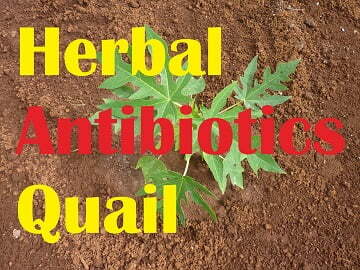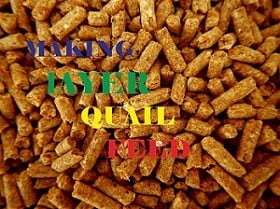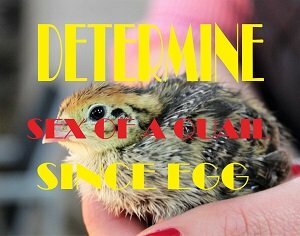In poultry disease management, for example, quail, we can use herbal antibiotics.
However, it might be a little troublesome.
The reason is, rare and almost no one sells herbal antibiotics. What is widely sold in the market are synthetic antibiotics.
Indeed, synthetic antibiotics are very practical. Just open it, then mix it with food and drinks, that’s fine. Just pray and hope the disease will disappear.
So, like it or not, if you want to use herbal antibiotics, you have to make them first.
In my previous article, I have discussed vitamins and herbal remedies for quail. The herbal plant is papaya leaves.
Did you know that it turns out that papaya leaves can also be used as herbal antibiotics?
Yes, there is a study using papaya leaf extract used in quail.
As it turned out, the results were pretty good. Later slowly at the end will come to the topic.
One of the concerns is the use of synthetic antibiotics that are not as recommended, which can actually lead to antibiotic resistance. Especially if the quail is exposed for a long time.
Antibiotic retention, the bacteria become resistant to the antibiotics used.
In other words, antibiotics don’t work.
Usually, this occurs because of a disease caused by a virus, but it is treated with antibiotics. So that the antibiotics are off-target.
Not only that, the use of antibiotics that are not as recommended can also lead to antibiotic resistance in livestock.
Antibiotics are only for diseases caused by bacteria. If the cause is a virus, antibiotics will not work.
Hence, for the use of antibiotics to be right on target, there is nothing wrong if we first understand what antibiotics are.
What are antibiotics?
Antibiotics are drugs that function to suppress the activity of harmful bacteria or kill them.
So, in particular, this antibiotic is indeed used to treat diseases caused by bacterial infections. Not because of a viral infection.
There are many kinds of antibiotics. There are at least a dozen types of antibiotics that are widely used today. [1]
Each – each has a special function for the treatment of certain types of bacteria.
If you want to know more about the types of antibiotics, please visit reference no [1]. If I describe it here, it can be very long because the use of antibiotics has a very wide range.
To make it more understandable, I take, for example, Tetracyclines. Tetracyclines are one type of antibiotic.
Tetracyclines are only effective against infectious diseases caused by the bacteria Mycoplasma, Chlamydia, Pasteurella, Clostridium, Ortnithobacterium rhinotracheale, and some protozoa.
Antibiotics in poultry
Antibiotics are very difficult to separate from poultry. In fact, poultry may not be possible without antibiotics.
This is because in general, antibiotics are used to:
treat diseases that have attacked poultry and
prevent poultry from the disease.
Lha, this disease must exist and attack every poultry farm. If there are no antibiotics that can be obtained quickly and easily, the livestock production process will be very troublesome.
However, it turns out that the use of antibiotics in developed countries such as America and Europe is very closely monitored.
For example, the use of sub-therapeutic doses of antibiotics in livestock has been banned since January 2017. Even in Europe, it has been banned since 2006. [2]
Subtherapy doses mean something like this.
To treat a certain disease, antibiotics are used. The dosage says the amount has been determined.
Subtherapy dose, cattle are given antibiotics but the dose is below the dose that has been determined earlier.
But the sub therapy dose is given to livestock in healthy conditions.
What’s the goal?
Reportedly, to maximize livestock productivity. More precisely, the feed is more efficient.
If feed is efficient, feed costs are reduced and the potential benefits can be increased.
Wow … this is a very interesting topic, feed efficiency.
But behind it all, if healthy livestock is continuously given antibiotics, it is feared that antibiotic resistance will occur.
If livestock is really infected with the disease, then the antibiotics commonly used are no longer effective in treating the disease.
Other than that…
This antibiotic may still be left in livestock products. Animal products can be meat, eggs, and milk.
If the product is consumed by humans, that is a cause for concern. Worried that this antibiotic resistance trait will pass to humans.
Thus, diseases experienced by humans will be more difficult to cure.
But this is still a big controversy. On the other hand, there is still much support for the use of this antibiotic.
In Indonesia, it seems that the use of this antibiotic is still very loose.
Papaya Leaf, a herbal antibiotics for quails
In my opinion, the use of synthetic antibiotics in quail should be reduced.
If it is reduced, then what is the substitute?
Instead, herbal antibiotics can use papaya leaves.
Indeed, not many have researched about this papaya leaf as a herbal antibiotic in quail. Meanwhile, the journal that I found was only this papaya leaf.
Hopefully, in the future, many Indonesian experts will start researching this natural antibiotic.
However, papaya leaves have long been used as traditional medicine.
The active ingredients contained in papaya leaves can be used as antibacterial.
According to research, papaya leaf extract can suppress the activity of bacteria such as E. Coli, K. pneumoniae., P. aeruginosa, and S. Aureus. [3]
It was also reported that:
The use of papaya leaves as an antibiotic can increase livestock productivity. Especially in quail.
The conversion of quail rations becomes better by giving this papaya leaf.
However, this papaya leaf will be more effective when given in its extract form.
How to extract it is quite easy. The steps are as follows:
Take a few papaya leaves (about 400 grams). Choose one that is not too old or young. Mediocre.
The papaya leaves are chopped into small pieces. About 1-2 cm.
Then add 2 liters of water and boil.
It’s better if you boil it with a small fire. [5]
Boil until the water becomes 1 liter. After that, it can be removed and the water can be called the papaya leaf extract. [4]
Papaya Leaves As Herbal Antibiotics For Quails
The productivity of quail given papaya leaf extract can increase.
Even better than quail gave synthetic antibiotics.
According to research, the amount of papaya leaf extract given to quail is as much as 30 ml. [5]
Giving it by mixing it with drinking water. Drinking water is provided unlimitedly or whenever it is available.
And apparently, egg production and conversion of quail rations given papaya leaf extract were higher.
In brief, I summarize the results of his research in the chart below.
In the picture above, the blue color is the percentage of egg production, while the orange one is the ration conversion (figure below).
So, during the research, the result obtained was that the productivity of quail eggs with the addition of papaya leaves was higher.
Only 63.63% of quail eggs were given antibiotics. Meanwhile, quail with added papaya leaves in drinking water, egg production was higher, namely 73.93%.
Besides, the ration conversion of quail to papaya leaves was also lower.
The ration conversion is 2.39. Whereas in quails with synthetic antibiotics, the ration conversion was higher, namely 2.71.
That means papaya leaves can indeed be used as a natural antibiotic in quail. Besides being able to increase the productivity of quail eggs, papaya leaves also make feed consumption more efficient.
If you use natural ingredients, there are usually no side effects. As long as the gift is also reasonable.
The use of natural ingredients in livestock is also safe for the long term. Unlike chemicals, which often cause side effects when used for a long time.
Besides, the cost of papaya leaves is also cheaper, right?
It’s just that, we need to sacrifice a little time and effort to make the extract first.
Yes … you have to be a little more patient and patient.
I think that’s enough for this article on papaya leaves as a natural antibiotic.
Actually, I myself am not satisfied because there is only a small amount of research that specifically addresses this.
Later, if there are other research journals, I will add the information here.
Ok, see you next week.
Reference
“If you want to know more, you can read the article below. If you want to read the journal directly you can too. Just contact me via comments. I’ll send you via email later”
[1] http://articles.extension.org/pages/66981/antibiotics-approved-for-use-in-conventional-poultry-production [2] https://en.wikipedia.org/wiki/Antibiotic_use_in_livestock#cite_note-:5-2 [3] Francis, E.F. And Vimala Jose. The Antibacterial Effect of Carica Papaya L. Extracts and Their Synergistic Effect with Antibiotic and Non-antibiotic Drugs. 16 (4): 1-11, 2016, Article no.BMRJ.28042. [4] Sudjatinah C.H.W. And P. Widiyaningrum. The Effect of Papaya Leaf Extracts on the Performance of Broiler Chicken Production. Faculty of Agricultural and Animal Husbandry Technology, Diponegoro University Semarang. J.Indon.Trop.Anim.Agric. 30 (4) December 2005. [5] Kusbiantari, A., Kardaya D., And Sudrajat D. The Effectiveness of Papaya Leaf Extract Through Drinking Water In Increasing Quail Egg Production. Journal of Nusantara Animal Husbandry ISSN 2442-2541 Volume 3 Number 1, April 2017. JOYNIM FARM Goat Farming, Cattle Farm, Laying Hens, Quail Farm, Gardening
JOYNIM FARM Goat Farming, Cattle Farm, Laying Hens, Quail Farm, Gardening







